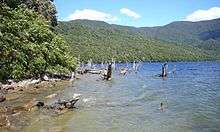Monowai Power Station
| Monowai Power Station | |
|---|---|
 Stumps from dead trees that were drowned when the lake level was raised in the 1920s | |
 Location of Monowai Power Station in New Zealand | |
| Country | New Zealand |
| Location | Southland |
| Coordinates | 45°46′34″S 167°37′3″E / 45.77611°S 167.61750°ECoordinates: 45°46′34″S 167°37′3″E / 45.77611°S 167.61750°E |
| Status | Operational |
| Commission date | 1926 |
| Owner(s) | Pioneer Generation |
| Thermal power station | |
| Primary fuel | Hydroelectric |
| Power generation | |
| Units operational | 3 |
| Nameplate capacity | 7.6 MW (10,200 hp) |
| Annual generation | 40 GWh (140 TJ) |
The Monowai Power Station, fed by the Monowai River from Lake Monowai in Southland, New Zealand, was one of the earliest hydroelectric power stations in the country. Originally commissioned in 1926,[1] it was recently overhauled and now contains modern turbines and plant, though the original buildings are still in use. It is owned by Pioneer Generation, who currently have a resource consent valid for 30 more years of operation. Before its recent refurbishment, the station produced 6.3 megawatts (8,400 hp) and 35–40 gigawatt-hours (130–140 TJ) of electricity per year.[2] Generating capacity has now increased to 7.6 MW.[3]
History
The first considerations for a Monowai hydro power plant were raised as early as 1914, when the Council of the Southland League investigated the natural resources in the area. The potential energy of the 46.93 metres (154.0 ft) fall from Lake Monowai into the Waiau River was seen as ideal. From the 1920s onward, more and more local areas in Southland began to be connected to the electricity grid, eventually leading to a start on work for a Monowai power station in 1921, led by H P Thomas as the Chief Engineer.[3]
The construction was funded by a £750,000 loan at 6% interest, with much of the equipment for the future station being purchased in London during a personal visit by the Chairman of the Board of the Southland Electric Power District. The equipment selected was Bowing Francis turbines (based on a Swedish design), with English Electric Company generators. The generators, originally excited by separate hydro turbine driven exciters, were two 0.85 power factor examples rated at two megawatts each. The plant was later increased to three generating systems.[3]
There were a number of maintenance overhauls throughout the history of the power station, but only in the 2000s were the original turbines and generators replaced. Various plans were considered, including a replacement of the three systems with a vertical 2.6-megawatt (3,500 hp) turbine and another larger vertical 5.3-megawatt (7,100 hp) turbine, allowing better accommodation of the changing river flows. This idea however failed, like later plans to use a single generator with one turbine at either end, partly because of the difficult access to the station, leading over a single-lane suspension bridge.[3]
It was therefore decided to go for a simple replacement of all three systems with new vertical turbines and associated generators. By 2007, the last system had been replaced, and the station now operates with three TURAB turbines from Sweden, and Spanish Alconza generators. The new equipment has increased the power to 2.6 megawatts for each of the now three turbines, operating at 94% efficiency. Maintenance requirements have dropped significantly with the new equipment.[3]
While some of the old equipment was scrapped, the second generator as well as the third turbine and generator were found to be salvageable and will be refurbished by a North Island company for use in another location.[3]
See also
References
Further reading
- Martin, John E, ed. (1991). People, Power and Power Stations: Electric Power Generation in New Zealand 1880 - 1990. Wellington: Bridget Williams Books Ltd and Electricity Corporation of New Zealand. pp. 316 pages. ISBN 0-908912-16-1.
- Reilly, Helen (2008). Connecting the Country: New Zealand’s National Grid 1886 - 2007. Wellington: Steele Roberts. pp. 376 pages. ISBN 978-1-877448-40-9.
External links
- Pioneer Generation website
- Department of Conservation - Lake Monowai/Borland Road information page